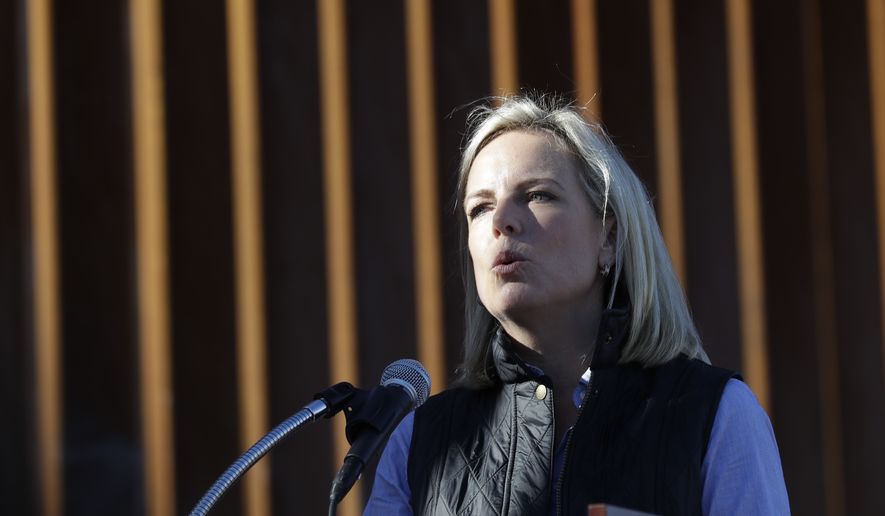Asylum-seekers streaming across Mexico to reach the U.S. will be shipped back across the border and made to wait in Mexico while their cases are decided, the Trump administration announced Thursday in a power-play bid to end the latest surge of illegal immigration.
Mexico has agreed to the plan and will offer humanitarian visas and work permits to the migrants — chiefly Central Americans — who will now wait on the southern side of the border, sometimes for years, for a chance to enter the U.S.
Homeland Security Secretary Kirstjen Nielsen said the goal is to end the “catch and release” practice that has enticed a wave of illegal immigrants to head north in recent years, convinced that they will be able to make bogus asylum claims and then slip into the shadows.
“They will not be able to disappear into the United States. They will have to wait for approval to come into the United States,” Ms. Nielsen told the House Judiciary Committee. “If they are granted asylum by a U.S. judge, they will be welcomed into America. If they are not, they will be removed to their home countries.”
Ms. Nielsen is triggering a 1996 law that says people who cross a land border seeking entry can be sent back and made to wait.
The law has never been tried, though President Trump has long hinted at his interest in using it. He included the language in one of his first executive orders in January 2017, and advisers have been debating its use in the months since.
One major reason the law hadn’t been triggered was resistance from Mexico.
Former Mexican President Enrique Pena Nieto said he would never allow it, but his term ended at the beginning of the month. New President Andres Manuel Lopez Obrador has been more open to dealing with Mr. Trump.
Mexico has agreed to allow the return of migrants and promised that it will offer protections while people wait for decisions from U.S. authorities.
“They will be entitled to equal treatment with no discrimination whatsoever and due respect will be paid to their human rights. They will also have the opportunity to apply for a work permit for paid employment, which will allow them to meet their basic needs,” the Mexican Foreign Ministry said.
Mexico’s reversal may have been eased by U.S. cash. The Mexican and U.S. governments announced this week a $10 billion American investment in nation-building in Central America and southern Mexico. The money will help fund civic institutions in Central America and economic opportunities throughout the region.
“I can’t overstate the significance of these developments,” Ms. Nielsen said. “We are taking lawful, unilateral action to stop illegal entry now. Mexico is taking its own appropriate actions in response. And our two countries have committed to a major regional plan to solve the crisis.”
Immigrant rights activists had feared such a deal and said it was cruel and dangerous to make migrants from Central America wait in Mexico.
“As long as Mexico fails in its obligations to protect asylum-seekers, families seeking protection would be endangered while in Mexico,” said Amnesty International Executive Director Margaret Huang. “The U.S. government must not continue endangering the safety of people who are only trying to rebuild their lives.”
Rep. Zoe Lofgren, California Democrat, said she expects the policy to be challenged in court.
“Your policy does not adhere to the requirements of the immigration law,” she told Ms. Nielsen during a meeting of the House Judiciary Committee.
Asylum cases can take years to resolve, and a massive backlog has built up as migrants game the system. Claims, which averaged fewer than 500 a month a decade ago, now near 10,000 a month.
Under U.S. policy, migrants need only say what officials deem the “magic words” — essentially claiming they fear being sent back home — to pass the initial asylum threshold, entitling them to make a full claim.
During that time, they are in the U.S.
Smuggling cartels tell about the ease of making claims, and migrants who have successfully exploited that path tell family and friends back home in Guatemala, El Salvador and Honduras, the chief countries responsible for the surge.
Making migrants wait in Mexico for years could serve as a significant deterrent because they won’t have a chance to gain a foothold in the U.S.
A report sponsored by the Homeland Security Department suggested that most of the migrants are coming to the U.S. because of jobs or family already in the country — not traditional reasons for asylum — and are unlikely to want to stay in Mexico.
Less than 20 percent of Central Americans end up qualifying for asylum, but few of the others are being deported, officials say.
Democrats said they feared the policy announced Thursday will punish the 1 in 5 migrants who have valid asylum claims, making them wait along with everyone else.
Rep. Jerrold Nadler, New York Democrat and incoming chairman of the House Judiciary Committee, said his solution would be to add more asylum officers and immigration judges to process the cases faster inside the U.S.
• Stephen Dinan can be reached at sdinan@washingtontimes.com.




Please read our comment policy before commenting.